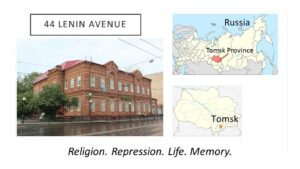Just a quick update: last Wednesday, as part of TRU’s 2nd Annual Research Week, I presented on the 44 Lenina project as part of the 180s Research Challenge. Based on the popular graduate student 3MT competition, in which each grad student has only 3 minutes to present his or her thesis, using only a static slide and no other props, the 180s Challenge does the same, except for faculty. Thirteen of us presented, on topics ranging from internet dating to “superhero” bacteria in caves. We were judged by TRU’s grad student winners. Nina Johnson‘s presentation, on using labyrinths to reduce stress in the classroom, won the competition. The whole event was great fun, and a wonderful way to get a snapshot of some of the research conducted at TRU: my thanks to the TRU Research Mentors and to TRU’s Office of Research and Graduate Studies, for organizing the event. Below is my introduction slide (basic info: format was the same for everyone) and my static slide from the competition. (Note that the photograph of 44 Lenin Avenue is my own, taken in August 2016, while the maps are modified, public domain maps, licensed through Wikimedia’s Creative Commons.)

